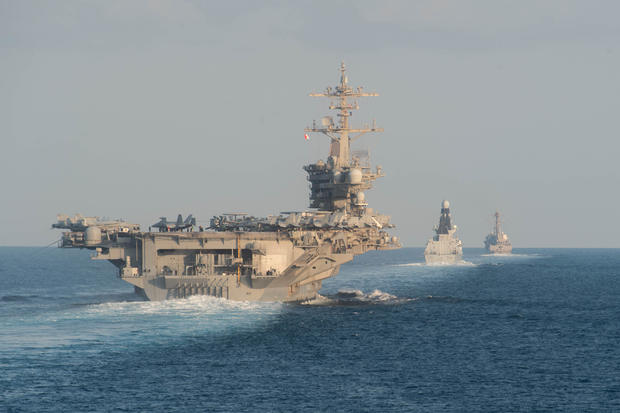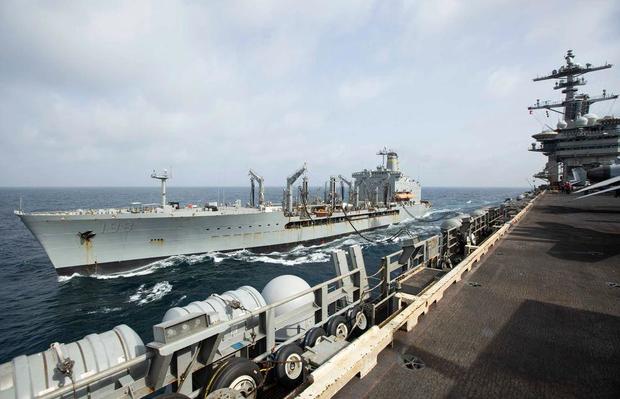The global security environment has dramatically shifted in recent years, with regional conflicts escalating, geopolitical rivalries intensifying, and military resources strained by emerging threats. From the waters of the Arabian Sea to the contested territories in the South China Sea, the stakes have never been higher for nations tasked with protecting their interests and maintaining global stability.
The U.S. Navy’s Role in Global Stability
The United States Navy remains one of the most powerful maritime forces in the world, with a vast array of resources designed to project power, protect commercial shipping lanes, and safeguard international waters. Yet, even the most capable navy faces operational limits when confronted with multiple threats across different regions. As the Middle East remains a hotspot of conflict and tension, the U.S. Navy’s ability to respond to emergent crises has become critical to both regional and global stability.
One of the most pressing examples of these challenges was seen recently when the USNS Big Horn, a vital oil replenishment vessel, ran aground off the coast of Oman. The Big Horn was the only replenishment vessel supporting the USS Abraham Lincoln Carrier Strike Group, deployed in the Middle East amidst the ongoing war between Israel and Hamas. As tensions soared between other Iran-backed groups, the incident underscored the fragile balance of maintaining operational readiness in such volatile regions.

The Critical Nature of Replenishment Vessels
Replenishment ships like the USNS Big Horn, often referred to as “oilers,” play a pivotal role in sustaining naval strike groups far from home ports. These vessels ferry fuel, food, and ammunition to ships and aircraft, allowing them to stay on station for extended periods. Without these logistical support vessels, the operational capacity of strike groups such as those centered around the USS Abraham Lincoln would be significantly hindered.
In the case of the Big Horn, U.S. officials reported significant damage to the ship, with partial flooding that required the vessel to be escorted to port by tugboats for a full assessment. The timing of the incident could not have been worse, with Abraham Lincoln and its associated Navy vessels actively patrolling the Arabian Sea in support of Israel and protecting U.S. assets in the region.
Despite the damage, Navy officials downplayed the long-term impact of the loss of the Big Horn, noting that alternative methods of refueling and resupplying the Lincoln Strike Group were still available. Nonetheless, the absence of the Big Horn underscored the vulnerability of the Navy’s logistical operations, particularly in high-stakes environments where the loss of a single ship can have outsized consequences.
Strategic Significance of the Arabian Sea and Red Sea Regions
The Arabian Sea and the Red Sea are vital regions for global maritime commerce. They also serve as critical theaters of operation for the U.S. Navy, which must constantly monitor threats from hostile actors. Among the most significant threats in the region are the Houthi rebels in Yemen, who have launched repeated missile attacks on both commercial and military vessels, including those passing through the Red Sea’s vital shipping lanes. The Houthis, backed by Iran, have justified their attacks as part of their support for the Palestinian cause in the ongoing conflict between Israel and Hamas.
The USS Abraham Lincoln Carrier Strike Group, with its mix of destroyers, aircraft, and support vessels, has been at the forefront of joint U.S.-British efforts to deter Houthi attacks and protect commercial shipping in the region. In recent months, numerous airstrikes carried out by U.S. and British vessels and aircraft have targeted Houthi missile sites in Yemen, yet the attacks on shipping have continued. This persistence has highlighted the limitations of even the most advanced military technology in fully neutralizing threats in an asymmetrical warfare environment.
While Abraham Lincoln itself is powered by a nuclear reactor, which allows it to operate independently of fuel supplies for extended periods, its supporting vessels rely on fossil fuels. This dependency places additional strain on the Navy’s logistical operations, which must ensure a steady flow of fuel to keep the strike group operational. With the Big Horn temporarily out of commission, the Navy has been forced to rely on port refueling for its destroyers and other vessels in the strike group. Although this workaround is feasible in the short term, it adds a layer of complexity and risk to the Navy’s operations in the region.
Global Threats and Naval Readiness
The incident involving the Big Horn comes at a time when the U.S. Navy is already grappling with a host of other challenges. Labor shortages in shipyards have led to backlogs in both ship production and maintenance while shifting defense priorities and cost overruns have strained the Navy’s ability to keep pace with emerging threats. Perhaps the most pressing of these threats is the growing assertiveness of China in the South China Sea, where it has been rapidly expanding its military presence and seeking to assert its territorial claims over disputed waters.
Eric Labs, a naval analyst at the Congressional Budget Office, has described the state of U.S. Navy shipbuilding as the worst in a quarter-century. According to Labs, labor shortages in key shipyards, coupled with last-minute design changes and other delays, have significantly slowed the production of new vessels, leaving the Navy with fewer ships at its disposal compared to China’s rapidly expanding fleet.
China’s growing naval power has raised alarm among military analysts and policymakers in Washington, particularly as Beijing seeks to project its influence in key strategic areas like the South China Sea and the Taiwan Strait. In response, the U.S. Navy has been increasingly called upon to maintain a presence in these contested regions, even as it continues to support operations in the Middle East and other theaters of conflict.
The Importance of Strategic Partnerships
One of the key ways the U.S. Navy has sought to mitigate the growing strain on its resources is through strategic partnerships with allied nations. The joint U.S.-British operation in the Arabian Sea is just one example of how the Navy has relied on allied support to maintain security in high-threat regions. British vessels and aircraft have played a critical role in deterring Houthi attacks and conducting airstrikes against Houthi missile sites in Yemen, providing much-needed support to the Lincoln Strike Group.
Similarly, the U.S. has worked closely with its European and Asian allies to counter China’s growing influence in the South China Sea. Joint naval exercises with nations like Japan, Australia, and South Korea have sent a clear message to Beijing that the U.S. and its allies are committed to maintaining the freedom of navigation in the region’s disputed waters.
However, while these partnerships have been effective in bolstering the U.S. Navy’s capabilities, they are not without their challenges. Differing strategic priorities among allied nations, coupled with the logistical difficulties of coordinating multinational operations, can sometimes hamper the effectiveness of joint operations. Nonetheless, the importance of these partnerships cannot be overstated, particularly as the U.S. Navy faces an increasingly complex and multifaceted security environment.

Challenges and Opportunities
As the U.S. Navy continues to grapple with the challenges of maintaining its operational readiness in a rapidly changing global environment, several key factors will shape its future operations. First and foremost is the issue of resource allocation. With the Navy stretched thin across multiple theaters of operation, from the Middle East to the South China Sea, the question of how to best allocate its limited resources will become increasingly critical.
The Navy’s ongoing shipbuilding woes are another major challenge that will need to be addressed if it is to maintain its technological and numerical edge over potential adversaries. Efforts to increase ship production and reduce maintenance backlogs will require significant investment in both infrastructure and personnel, as well as a renewed focus on efficiency in the shipbuilding process.
At the same time, advancements in technology present new opportunities for the Navy to enhance its capabilities. The development of unmanned surface and underwater vehicles, as well as advances in artificial intelligence and cybersecurity, have the potential to revolutionize naval warfare in the coming years. These technologies could allow the Navy to operate more efficiently and effectively, even in the face of resource constraints and emerging threats.
Finally, the Navy’s ability to adapt to the evolving security environment will depend on its continued collaboration with allied nations. As the U.S. faces rising challenges from both state and non-state actors, its partnerships with allies in Europe, Asia, and the Middle East will be essential in maintaining global stability and ensuring the free flow of commerce through the world’s vital shipping lanes.
Navigating a Sea of Uncertainty
The U.S. Navy finds itself at a critical juncture, facing a host of challenges that threaten to undermine its ability to maintain its status as the world’s premier maritime force. From labor shortages and shipbuilding delays to rising threats in the Middle East and the Pacific, the Navy must navigate an increasingly complex and dangerous global environment. Yet, despite these challenges, the Navy’s commitment to protecting U.S. interests and maintaining global stability remains steadfast.
The incident involving the USNS Big Horn is a stark reminder of the Navy’s dependence on its logistical support vessels, as well as the potential vulnerabilities that can arise when those vessels are compromised. However, the Navy’s ability to adapt and overcome such challenges, coupled with its strong partnerships with allied nations, ensures that it remains a formidable force capable of responding to crises wherever they may arise.
As the Navy looks to the future, it must continue to invest in new technologies, increase the efficiency of its shipbuilding processes, and strengthen its alliances with key partners around the world. Only by doing so can it maintain its operational readiness and continue to fulfill its mission of safeguarding global peace and security in an increasingly uncertain world.



